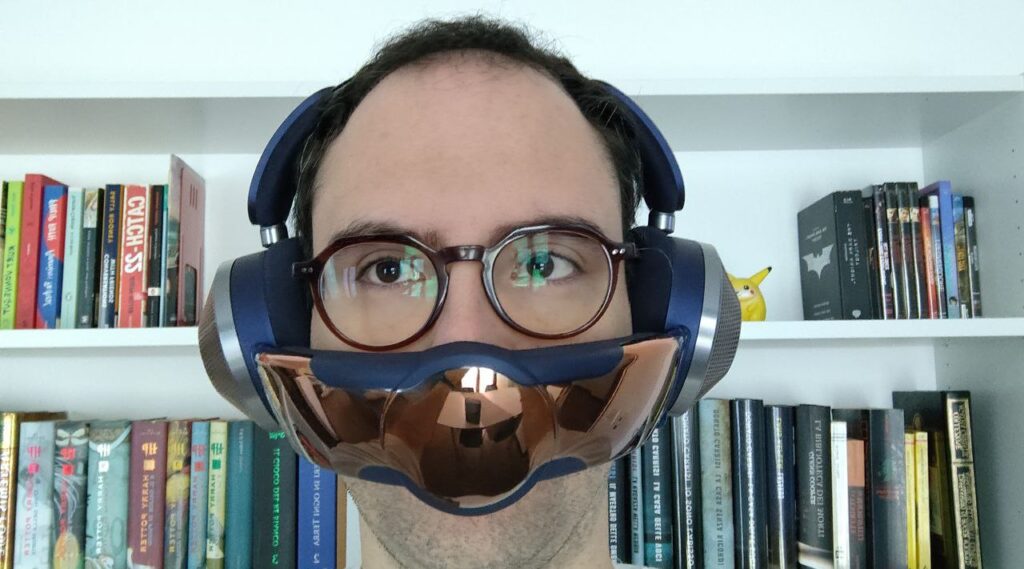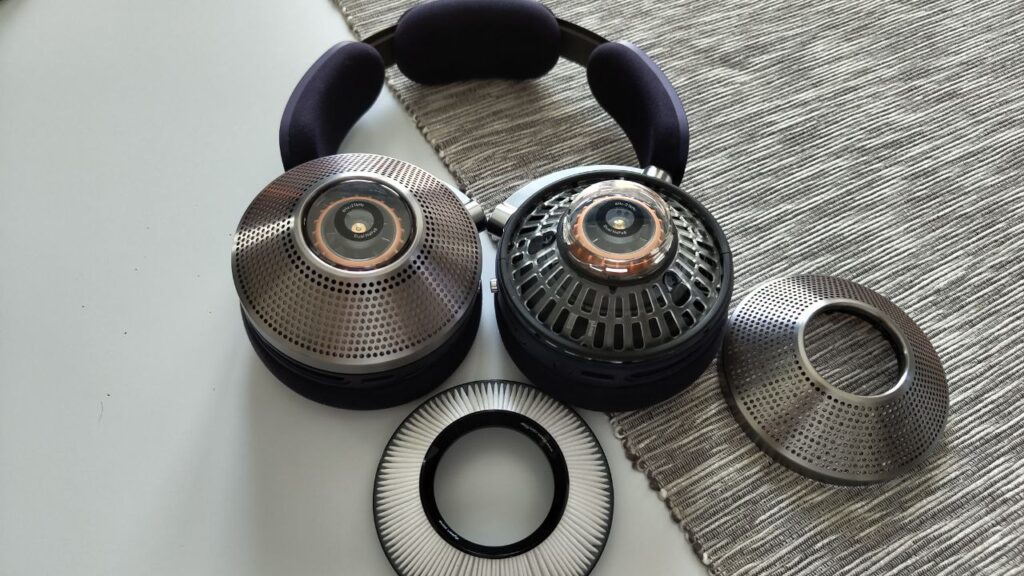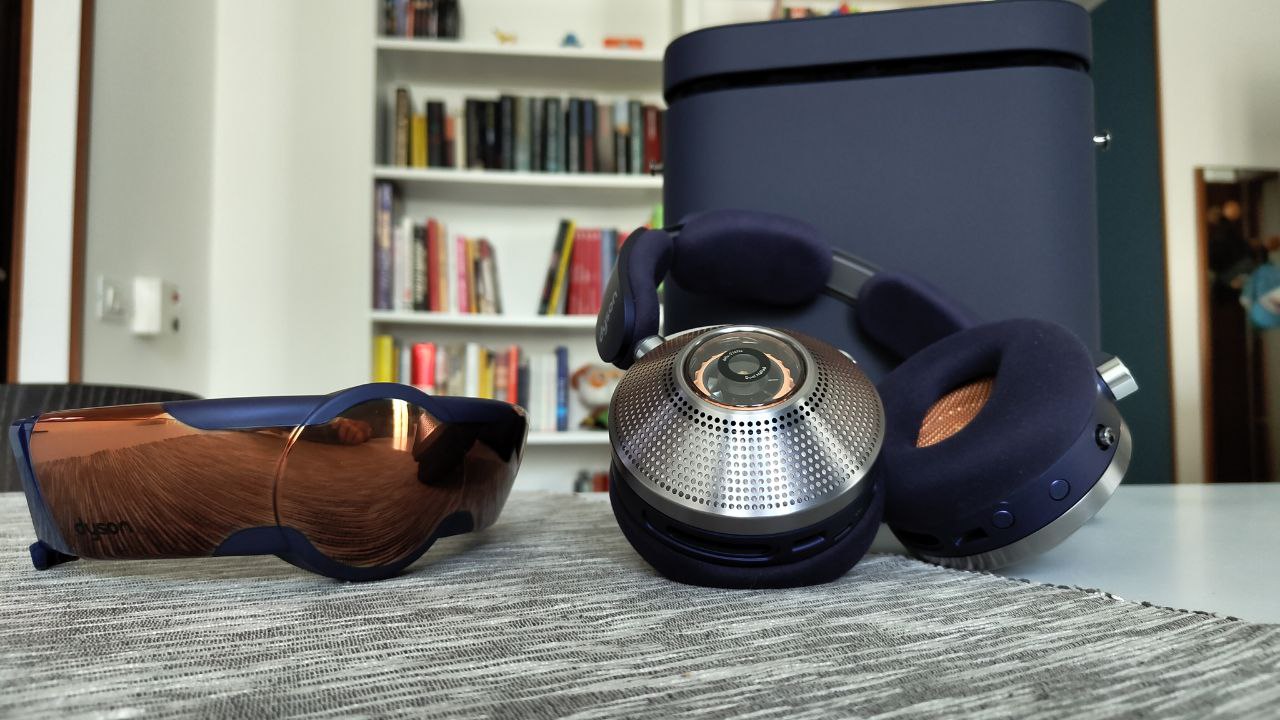Dyson builds designs and builds vacuum cleaners, hair dryers, fans and air purifiers. So why did he put all his engineering acumen into a pair of headphones? Innovation doesn’t always pay off, especially in the first generation. In this Dyson Zone Absolute+ reviewtherefore, we do not want to help you decide whether to buy this product. Unless you have a Daft Punk cover band, we advise against spending 959 euros to do so: for this price you can get headphones with better sound, and buy yourself a spare pair. Rather, we want to ask whether some headphones with air purification such as the Dyson Zone make sense. And whether Dyson can do better with the next generation – if there will be.
Why we have to admit it: although the Dyson Zones didn’t convince us, they undoubtedly intrigued us. They are an interesting and innovative product. While we think they have some unforgivable flaws, we appreciate the novelty. And the quality of materials and design can be seen. So what went wrong? And can it be fixed?
The Dyson Zone Absolute+ review
Here is the whole intelligent world of Dyson
After doing the rounds of all social networks, Dyson Zones also debut in Italy (with Tananai as ambassador) and we were very curious to try them. But also a little fearful. Dyson has made some really interesting products – revolutionizing the world of vacuum cleaners, for example. But the Dyson Zones seemed too “special” and expensive to be successful. And we don’t like giving negative reviews: we prefer to try products that are easy to recommend. Perhaps, we were also a little afraid of using headphones and a purifying mask in public – we have to admit it.
But we tried to Evaluate air-purifying headphones putting prejudices aside, testing them with all the honesty we are capable of. And after listening to tons of songs and purifying the air in front of our faces, we have to say that there are several features where Dyson has positively impressed us. Enough to recommend the purchase? No. But enough to ask: Does Dyson have a place in the audio world?
The weight of a futuristic design
First, let’s talk about the elephant in the room, to put it plainly: the futuristic design of the Dyson Zone. And we’re not talking about the elephant just because it’s the most talked about issue online – but also because of the weight of the headphones and all the accessory pack that comes with them.
 “I’m Gotham’s reckoning”
“I’m Gotham’s reckoning”
The package weighs almost three kilos, also because Dyson has not spared itself on accessories. Find a large travel case (the same color as the headphones), with its own long cord to carry it like a shoulder bag. And then velvet cases for both the headphones and the visor, a long USB-C cable for recharging, adapters for air travel and a jack remover, two electrostatic filters for purification and two spares, a cleaning brush of the visor.
But even headphones alone weigh too much. Indeed, if we exclude the visor, the excessive weight and dimensions of the headphones were found to be the Dyson Zone’s biggest problem during our review. Pavilions must leave plenty of room for filters and motors to draw in air from outside to purify it. The result is that they stick out a lot, making them uncomfortable (don’t think you can doze off on the side in a car or plane).
Il weight of 635 grams it is well above the average wireless headphones. If you listen while standing or sitting, you can also ignore it. But if you move your head, the weight problem resurfaces. Not only can’t you play sports with them, you won’t even want to walk too far with them on your ears. We spent the morning wearing headphones while working and they seemed uncomfortable.
Great materials and unique look – but at what cost?
The model sent to us by Dyson base color is Prussian Blue, with copper-colored accents. Which can be seen not only on the visor, but also inside the headphones and in the velvet cases. Dyson has taken great care of the detail, both of the visor and of the headphones. But they are drastically different when it comes to the materials used to make them.
If the headphones are made of metal, with soft micro-suede pads on both the ear cups and the adjustable headband (there are three comfortable pads), the visor is made of lightweight plastic. The goal is undoubtedly not to further increase the weight of the headphones.

But the very different consistency almost makes the two components seem immediately noticeable and a bit out of place for this device, so attentive to detail.
In fact, we cannot deny that Dyson’s attention in making every millimeter of these headphones cannot be seen. Rather, we think that perhaps it would have been better to use less noble but lighter materials to make the headband and the attachment on the pavilions. This would have lowered the weight and the price, which seem more important to us than the quality of the materials themselves. Sure, the Dyson Zones may be harder to crack in the long run than rival headphones. But if they weigh too much to keep them on their heads, the game may not be worth the candle.
Plenty of space dedicated to filtering. But it works?
After weighing its weight and materials for this review, while giving it a good charge via USB-C, we disassembled the Dyson Zone’s perforated bezel. In fact, it is below that you can insert the HEPA filter to purify the air, above the plastic structure that you see in the photograph.

As you can see, the space dedicated to filtering is really a lot. Indeed, on the Dyson website we read that the battery of these headphones (which lasts up to 50 hours for listening, but only 4 with purification) is located on the headband. So all the space not taken up by the many microphones (8 ANC, 2 sound reduction and one for the phone) and the 40mm driver (pretty standard for high quality headphones) goes to the air filtration.
Activating it is quite simple. Once the first test has been carried out using the MyDyson app, just attach the visor magnetically to start filtration. The first time we struggled to find the right hook – but after we more or less figured out the position, it immediately entered our muscle memory and activating them takes a second.
Purifying the air is so important to these headphones that the Dyson Zones don’t have a power button: to turn the headphones on and off, you have to press the air button.
Il air flow adjusts automatically (although you can change it from the app or with the aforementioned button), shooting a jet of fresh air in front of the nose and mouth. The three levels depend on your movement: if you’re walking briskly, the flow gets stronger, to give you more air to breathe. At maximum speed, if you pause the audio you will hear the hum of the engine filtering the air. But above all, those around you feel it. It’s not annoying, but feel it.

The filters capture 99% of polluting particles down to 0.1 microns, with a layer of activated carbon which captures nitrogen dioxide and sulfur dioxide. But beware: they do not protect against viruses and bacteria – if you are influenced or do not want to get infected, you will have to keep an FFP2 mask under the visor. Nor does it remove odors altogether, although it “reduces” them by placing a physical barrier to get to your nose.
Although the air on the face is pleasant, the impact it has on the battery seems too much to justify its use. We think Dyson thought of the Zones above all as headphones, to then use the visor if, after getting off the subway or car, you have a stretch to walk in a very polluted city (like almost every city). Perhaps someone will find it natural to keep the visor in his pocket and attach it to avoid smog. We did it just out of curiosity and out of duty, while writing this Dyson Zone review.
Dyson Zone review: the audio isn’t bad
Despite all the space taken up by the filter system, the Dyson Zone have not bad audio. The headphones reproduce songs with deep bass like Kendrick Lamar’s Loyalty very well, without losing the treble and mids in complex songs like Free by Florence + The Machine.

In symphonic songs and jazz tracks, the musical quality seems to us to be up to many other wireless headphones, even without reaching the top of this category. Some sound details are missing: Audio is not flat, but less bright and dynamic than other headphones.
And then there is the problem of weight: Metallica’s Master of Puppets sounds very good, but if we hit our heads to the beat, our necks start to hurt.
ANC, Transparency, smart commands and calls
Noise cancellation seems to us to be very good. Again, don’t be on the excellence offered by other rivals in the realm of wireless headphones. But at home it cancels the noise of the robot vacuum cleaner and outside the house the noise of the traveling train or city traffic. However, louder noises such as the spin of a washing machine (at least one as old as ours) or a screeching train braking remain audible. The voices of people at normal volume disappear, but by raising the pitch you can still hear something.
The Transparency mode is also good, which you can activate with two taps on the headphones or from the app. It allows you to hear all the noises that used to disappear, you can…















Leave a Reply
View Comments